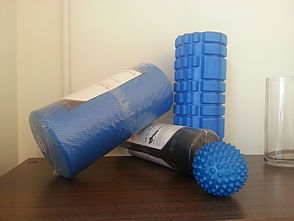Foam roller, advice from your Myotherapist

Foam Roller
Foam rolling is a great way to self treat before or after exercise. Stretching and massaging your muscles and connective tissue, they increase circulation and muscle relaxation (when used correctly). Rollers come in different densities and textures depending on the the level of satist inside you. The smoother and less dense is less intense. While the more dense and rougher are more intense. See the below picture for some different types.
So what are some of the benefits of using a foam roller?
– Increase circulation
– Stretching muscle
– Stretching fascia
– Breaking up adhesions
– Increasing range of motion
– Making movement smoother
How to use them
Like all things to do with exercise, technique is crucial to getting the
best results with minimal effort. Depending on if you want to affect fascia or
muscle you will need to modify your technique slightly. If you are wanting to
stretch fascia, the slower the better when using them. Recent fascial
research recommends moving 1-2mm per breath to affect fascia. Anything faster than that, you are sliding over it and targeting the muscle.
Where on the body to use them?
Foam rollers can be used on any muscle that it can come into contact with. They are typically used on large bulky muscles but connective tissue can be targeted as well. As an example, a common area for foam rollers to be used on is the ITB (iliotibial band).
This is the long thick band that runs the length of the outside of each thigh (common problem area for runners and cyclists). Being made up of connective tissue (fascia) rather than muscle, it has little to no stretch. Making it succeptible to adhering to surrounding structures. Foam rolling is a great way to iron out the kinks and break down the adhesions allowing the ITB to slide along the surrounding structures, making movement greater and smoother. (because the ITB has little to no stretch it is essential to roll the main muscles connecting into it, TFL and Gluteus Maximus, to get the maximim benefit)
Here are a few examples of foam rollers being used on different muscles.
1. Adductors – lying on your left side in the recovery position. Place the roller on the inside of your knee. Start rolling from knee to groin and switch to other leg when done.
Tip: Externally or internally rotate your thigh to target more inner hamstring or quad.

2. Calfs – sitting on the ground, put your left calf on the roller with the right
ankle on top of your left. Use your hands to push your backside off the floor,
putting more pressure on your calf. Roll your left one out then switch to your right.
Tip: Try and keep your back straight, push your top leg down onto the one you
are rolling to make the massage more intense.

3. Quads – lying facedown place your left quad on the roller. Use your forearms to hold your chest off the ground slightly and start rolling. Switch to your other leg when done.
Tip: Keep your back straight, push your opposite leg down onto the one you are rolling to make the massage more intense.

Use the above information as a guide only. Always consult a health professional before using a foam roller to make sure you have no underlying conditions that may contraindicate roller use.
Questions on purchasing one or for more information can be directed to your local Myotherapist or health professional.
Happy Rolling!
The Palpation Clinic
P: 03 5248 7321 E: info@palpate.com.au W: www.palpate.com.au

